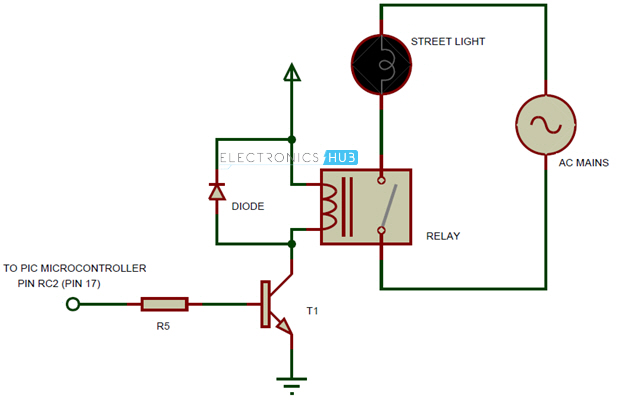treet lights are controlled manually in olden days. These days automation of street lights has emerged. But one can observe that there is no need of high intensity in peak hours i.e. when there is no traffic and even in early mornings. By reducing the intensity in these times, energy can be saved to some extent.
There are many methods to save the power like Switching the street light on detecting vehicle , Street light controlling using LDR and relays etc. The proposed circuits controls street light intensity by calculating the peak hours.Two circuits are shown in this article,one explaining the street light control using ATmega8 and second explains street light controlling using PIC microcontroller. Most commonly found street lights are HID or High Intensity Discharge lamps, which consume a lot of power. In order to save energy, the circuits are designed with high intensity LEDs in place of HID lamps.
Auto Intensity Control of Street Lights using ATmega8
Circuit Principle
The main principle of this project is to Control the intensity of street lights using PWM.Peak hours of a particular area are calculated and accordingly PWM signal is adjusted by microcontroller to increase or decrease the intensity of street lights.
These peak hours can be calculated by considering parameters like traffic density,time, light intensity of the environment.
Circuit Design
The auto intensity control of street lights circuit is simple but it requires more coding part. This circuit consists of Atmega8 controller, DS1307, LDR, Relay and LEDs.
LDR:LDR is used for calculating the light intensity of the environment .The light dependent resistor is connected to ADC1 (PC1) pin of the micro controller. The analog light value is converted to digital value using ADC.
RTC:Current time is calculated using RTC. Real time clock has 8 pins out of which SCL and SDA are connected to PC5 andPC4 pins respectively. SCL is serial clock while SDA is serial data RTC is I2C compatible, where I2C means inter integrated circuit. One bit of data is transmitted on data bus for each clock cycle.
Data can be transferred between devices, using only two bi-directional buses. Each device can act as a slave or master. The slave devices will have one address and these devices can be accessed using this address.
LCD:LCD is the display used for displaying time which is read from RTC IC. Interfacing of LCD in 4-bit mode is shown in circuit diagram. D4-D7 pins of LCD are connected to PD0-PD3 pins of microcontroller.
RS pin of LCD is connected to PD4 pin of micro controller. RW and Enable pins are connected to PD5 and PD6 pins of controller.
LED array is number of high power LEDs connected in series. It is connected to PWM pin of the microcontroller.
I2C Protocol
I2c is a communication protocol invented by Philips Company. This is well suited for communication between integrated circuits and peripherals. This uses two lines to transfer data.
- Serial Data – SDA
- Serial Clock – SCL.
- This can connect up to 128 devices using two wires. Each device connected will have an address. The device which initiates the data transfer is called Master.
- Every device will have 7 bit address.
- Master initially sends the START bit on the data line.
- Then it sends the address of the device with which wants to communicate and the mode of operation i.e. read or write.
- The slave devices listen to the incoming data and checks if its address matches to the received data. The device whose address matches send an acknowledgement signal.
- Then master starts transmitting or receiving the data from the slave.
- After completion of the transmission, Master sends a STOP bit.
- Data on SDA can be changed only if SCL pin is low.
For more detail: Intensity Control of Street Light


